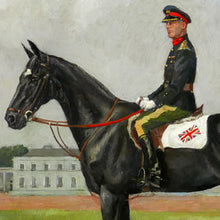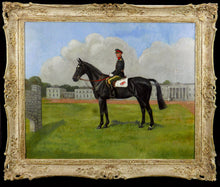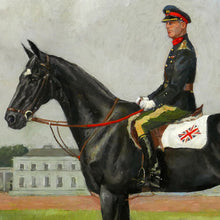Portrait of British Equestrian Team Showjumper Brigadier ‘Monkey’ Blacker, 1961
Adding product to your cart
Overall: 78cm (in) x cm (in)
Oil on canvas. Brigadier Cecil ‘Monkey’ Blacker in the uniform of the 5th Royal Inniskilling Dragoon Guards mounted on ‘Workboy’ in front of the Royal Military College, Sandhurst of which he was Assistant Commandant from 1960-1962. Signed and dated ‘E. Aglionby 1961’.
General Sir Cecil Hugh Blacker G.C.B., O.B.E., M.C., (1916-2002) was educated at Wellington College and Sandhurst, and was commissioned into the 5th Royal Inniskilling Dragoon Guards in 1936. The regiment was mechanised in 1939, but Blacker continued to keep a charger which he rode with success in point-to-point races. He went to France with the British Expeditionary Force in 1939 and was adjutant of his regiment during the Germans attack in the west and the Dunkirk evacuation in May and June 1940. In 1941 he was appointed to the command of the wartime raised 23rd Hussars, which as part of the 11th Armoured Division, fought with distinction across North-West Europe in 1944-45 and suffered more than its established strength in casualties. Blacker was awarded the Military Cross in 1944 following Operation Goodwood.
Read more
After the war he combined his military career with competitive riding as an Amateur Steeplechaser and International Showjumper. In the 1948 he rode in the Grand National, and was selected to join the British modern pentathlon team. In 1951 represented Great Britain in the world championships in Sweden. In 1954 he won Grand Military Gold Cup. He was appointed to the command of the Inniskilling Dragoon Guards at Catterick in 1955 and hunted regularly with the Zetland and Bedale. He continued showjumping with his horse Workboy in Germany when his regiment was posted there. From 1958 to 1960, he worked in Whitehall and represented Great Britain at international events.
After two years as assistant commandant at Sandhurst, he was appointed to command 39 Infantry Brigade in Northern Ireland. In 1964, at short notice, the brigade was sent to take part in operations in the Radfan, in Yemen. Appointments to GOC 3 Division, the Ministry of Defence and as lieutenant-general with northern command, based at York, followed. In 1969, he successively became vice-chief of the general staff at the MoD. With the start of the Northern Ireland troubles, and as adjutant general, he was targeted when a suitcase of gelignite was left at his official residence.
He retired in 1976 to devote more time to horse racing administration. A Jockey Club member and a deputy senior steward in the 1980s, he took charge of the Newmarket dope-testing laboratory, and was one of the two Jockey Club members of the Horserace Betting Levy Board. General Blacker was colonel commandant of the Royal Military Police (1971-76) and colonel commandant of the 5th Royal Inniskilling Dragoon Guards (1972-81). He wrote for the Spectator and penned several books including ‘The Story of Workboy’ (1966) and ‘Monkey Business’ (1993).








